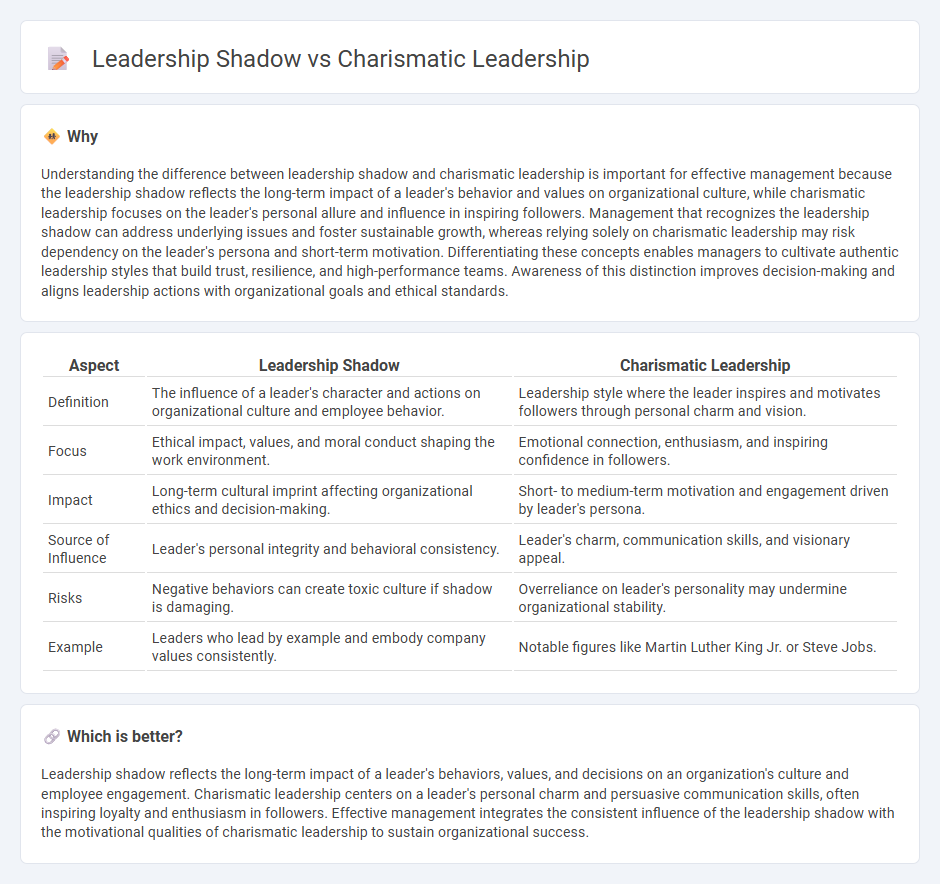
Leadership shadow emerges when a leader's unspoken behaviors and values influence organizational culture, often shaping employee conduct beyond formal directives. Charismatic leadership relies on a leader's magnetic personality and vision to inspire and motivate followers toward shared goals. Explore how these contrasting leadership styles impact team dynamics and organizational success.
Why it is important
Understanding the difference between leadership shadow and charismatic leadership is important for effective management because the leadership shadow reflects the long-term impact of a leader's behavior and values on organizational culture, while charismatic leadership focuses on the leader's personal allure and influence in inspiring followers. Management that recognizes the leadership shadow can address underlying issues and foster sustainable growth, whereas relying solely on charismatic leadership may risk dependency on the leader's persona and short-term motivation. Differentiating these concepts enables managers to cultivate authentic leadership styles that build trust, resilience, and high-performance teams. Awareness of this distinction improves decision-making and aligns leadership actions with organizational goals and ethical standards.
Comparison Table
| Aspect | Leadership Shadow | Charismatic Leadership |
|---|---|---|
| Definition | The influence of a leader's character and actions on organizational culture and employee behavior. | Leadership style where the leader inspires and motivates followers through personal charm and vision. |
| Focus | Ethical impact, values, and moral conduct shaping the work environment. | Emotional connection, enthusiasm, and inspiring confidence in followers. |
| Impact | Long-term cultural imprint affecting organizational ethics and decision-making. | Short- to medium-term motivation and engagement driven by leader's persona. |
| Source of Influence | Leader's personal integrity and behavioral consistency. | Leader's charm, communication skills, and visionary appeal. |
| Risks | Negative behaviors can create toxic culture if shadow is damaging. | Overreliance on leader's personality may undermine organizational stability. |
| Example | Leaders who lead by example and embody company values consistently. | Notable figures like Martin Luther King Jr. or Steve Jobs. |
Which is better?
Leadership shadow reflects the long-term impact of a leader's behaviors, values, and decisions on an organization's culture and employee engagement. Charismatic leadership centers on a leader's personal charm and persuasive communication skills, often inspiring loyalty and enthusiasm in followers. Effective management integrates the consistent influence of the leadership shadow with the motivational qualities of charismatic leadership to sustain organizational success.
Connection
Leadership shadow represents the implicit influence leaders have on organizational culture and behavior, often shaping employee attitudes and decision-making. Charismatic leadership amplifies this shadow by projecting a compelling vision and emotional appeal that inspires loyalty and commitment. Together, they create a powerful dynamic where the leader's presence profoundly impacts organizational performance and ethical standards.
Key Terms
Charismatic Leadership:
Charismatic leadership centers on the leader's ability to inspire and motivate followers through exceptional personal charm, vision, and communication skills, fostering strong emotional connections and loyalty. This leadership style often drives innovation, organizational commitment, and enhanced team performance by leveraging the leader's powerful presence and influence. Explore the dynamics of charismatic leadership to understand its impact on organizational success and follower engagement.
Influence
Charismatic leadership centers on using personal charm and vision to inspire and influence followers, often resulting in strong emotional connections and high motivation. Leadership shadow, however, refers to the negative or unintended influence a leader's behavior and decisions may cast, potentially undermining trust and effectiveness. Discover how understanding these dynamics can enhance your leadership impact.
Vision
Charismatic leadership centers on inspiring a compelling vision that energizes and motivates followers toward shared goals, often characterized by strong personal influence and communication skills. In contrast, leadership shadow refers to the unintended negative aspects or behaviors of a leader that can obscure or diminish the clarity and effectiveness of the visionary message. Explore how maximizing visionary strengths while mitigating leadership shadow effects can enhance organizational impact.
Source and External Links
Charismatic Leadership 101: Advantages, Disadvantages, and ... - Charismatic leadership is a style where leaders use their personal charm, confidence, and persuasive communication to inspire and influence followers, motivating them to achieve goals even amidst adversity; notable examples include Martin Luther King Jr. and Nelson Mandela, but this style can sometimes lead to unethical behavior and uncritical acceptance by followers due to emotional manipulation.
What Is Charismatic Leadership: Meaning, Theory, Style & Examples - Charismatic leaders stand out through authentic and empathetic communication that inspires others by clearly articulating their vision, fostering open dialogue, ethical decision-making, and motivating teams with a strong moral compass, as exemplified by leaders like Martin Luther King Jr.
What Is Charismatic Leadership? - This leadership style relies on strong communication, emotional connection, forward-thinking, and grace under pressure to engage and motivate teams, often employing unconventional methods to achieve goals while being sensitive to team needs.
 dowidth.com
dowidth.com